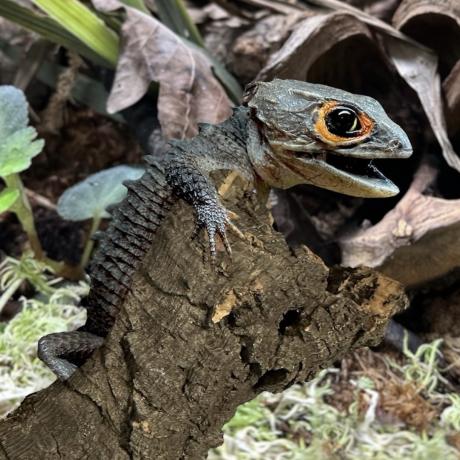

The Red Eyed Crocodile Skink reaches an adult size of 18 to 20cm head to tip of tail. They are native to Indonesia and the surrounding Islands.
These shy lizards look more like a miniature crocodile or dragon rather than a species of skink. They grow to around 16-20cm in length and their body scales are rough, with three hard, spiky projections running along their back down to the tip of the tail. The eyes are unique with a red/orange ring around the eye socket and yellow in the corner of the eye.
Sexing of Red Eyed Crocodile Skinks is not difficult. A close inspection of the underside will show a section which looks like a belly button; males tend to have larger scales in this area compared to females. They reach maturity in their third or fourth year and live to an average life span of 12-15 years.
They are native to Indonesia from Irian Jaya and Papua New Guinea. Red Eyed Crocodile Skinks live in moist areas close to water.
It is recommended to keep Red Eyed Crocodile Skinks in a spacious but heavily cluttered terrarium which can withstand high humidity levels. They are secretive by nature and are a pet which is best observed and left to their own devices, they do not enjoy being handled and stress can be fatal in this species.
A 36x18x18" vivarium or glass tank will house an adult pair, but do not house males together as fighting may occur. The enclosure should be heated to an ambient air temperature of 28C (82F) with a basking area of 32C (89F). Allow night time temperatures to cool down to 22C (72F). The use of a thermostat is essential and ensures that the temperature your animal requires is kept constant, with no risk of over/under heating.
The Red Eyed Crocodile Skink may be nocturnal, but the provision of a low percentage of UVB Light is still essential. Whilst limited, they would have some natural exposure to the sun in the wild, so it is vital to provide your skinks with access to low level UVB lighting that sits within the parameters of Ferguson Zone 1. This helps them to produce vitamin D3 which is essential in the absorption of Calcium - keeping bones healthy and strong. This should be on for 12 hours during the day and turned off at night. If you intend to grow live plants in the terrarium you must also provide suitable LED lighting for them to be able to thrive.
They are found mostly in primary forests which are notoriously humid, their natural humidity levels will fluctuate and can rise and fall between 80-95%. Use a substrate which can hold some moisture such as Coco Fibre mixed with a good bio-active forest ground cover. To ensure this does not stagnate in the damp conditions, we recommend adding in a drainage layer and mesh for bio-active setups, then the substrate to cover the floor and then a layer of leaf litter and moss on top can help to retain moisture.
Hides should be provided throughout the enclosure, humidity hides are essential as 80-95% humidity is ideal. For cage décor, provide cork oak branches or bark for them to climb over or hide under, combined with live or artificial plants. Ensure you fill out the enclosure well, to provide plenty of coverage so that your skink feels secure.
Fresh water should be provided daily in a large water dish or tray, ensure this is not too deep and place some stones in a tray to prevent your skink from drowning. Feed on a range of live foods like crickets, locusts, wax worms, mealworms and feeder roaches. Young skinks should be fed daily and adults every two to three days. On all live feeds, it is important to use a good quality supplement powder to provide an essential calcium and vitamin boost to your skink. The easiest method of application is to use a spare live food tub to dust the insects lightly in supplement. We advise dusting your insects on every feed, alternating between calcium and vitamin powders according to manufacturers recommendations.